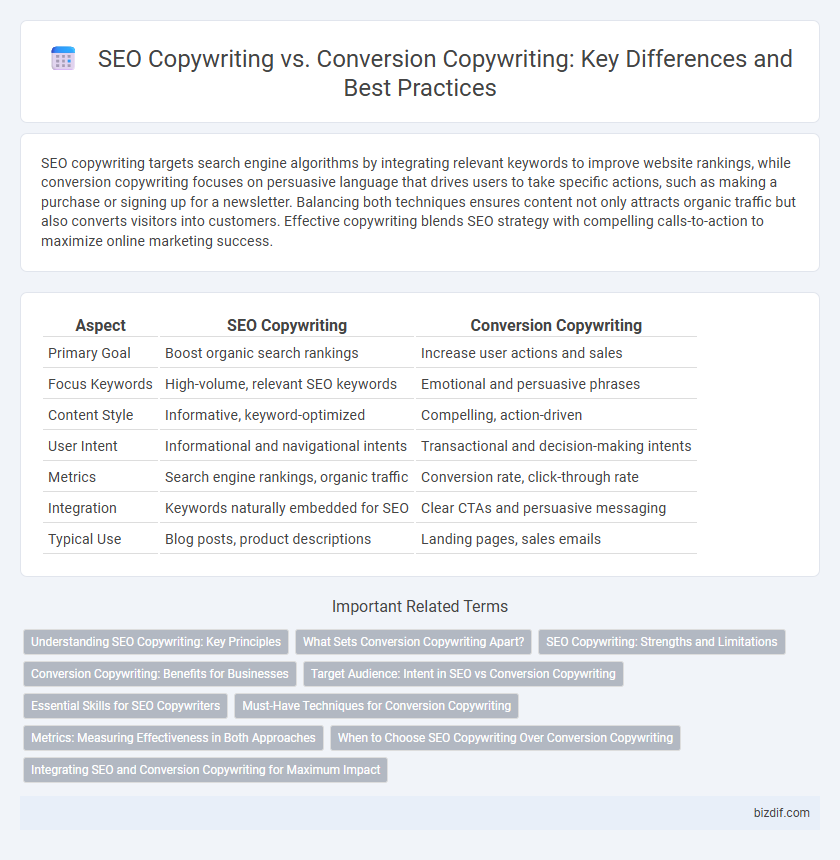SEO copywriting targets search engine algorithms by integrating relevant keywords to improve website rankings, while conversion copywriting focuses on persuasive language that drives users to take specific actions, such as making a purchase or signing up for a newsletter. Balancing both techniques ensures content not only attracts organic traffic but also converts visitors into customers. Effective copywriting blends SEO strategy with compelling calls-to-action to maximize online marketing success.
Table of Comparison
| Aspect | SEO Copywriting | Conversion Copywriting |
|---|---|---|
| Primary Goal | Boost organic search rankings | Increase user actions and sales |
| Focus Keywords | High-volume, relevant SEO keywords | Emotional and persuasive phrases |
| Content Style | Informative, keyword-optimized | Compelling, action-driven |
| User Intent | Informational and navigational intents | Transactional and decision-making intents |
| Metrics | Search engine rankings, organic traffic | Conversion rate, click-through rate |
| Integration | Keywords naturally embedded for SEO | Clear CTAs and persuasive messaging |
| Typical Use | Blog posts, product descriptions | Landing pages, sales emails |
Understanding SEO Copywriting: Key Principles
SEO copywriting centers on integrating targeted keywords naturally within engaging content to improve search engine rankings and increase organic traffic. It emphasizes thorough keyword research, on-page optimization, and creating high-quality, relevant content that satisfies both user intent and search algorithms. Effective SEO copywriting balances readability with strategic placement of keywords to enhance visibility without compromising the audience's experience.
What Sets Conversion Copywriting Apart?
Conversion copywriting centers on crafting persuasive, action-driven content designed to maximize user engagement and boost sales metrics. It employs psychological triggers, clear calls-to-action, and audience-focused messaging to directly influence decision-making processes. Unlike SEO copywriting, which prioritizes keyword optimization for search engine rankings, conversion copywriting prioritizes turning visitors into customers through compelling, conversion-focused language.
SEO Copywriting: Strengths and Limitations
SEO copywriting excels in improving organic search rankings by integrating targeted keywords and optimizing content structure for search engines, which increases visibility and drives consistent traffic. Its strengths lie in enhancing website authority, boosting click-through rates through meta tags, and aligning with search algorithms to capture relevant audience searches. However, SEO copywriting may fall short in engaging readers emotionally or driving immediate conversions, as the focus on keyword density and technical optimization can sometimes compromise persuasive messaging and user experience.
Conversion Copywriting: Benefits for Businesses
Conversion copywriting enhances business performance by crafting persuasive, customer-focused content that drives action and boosts sales. It emphasizes understanding target audience pain points and desires to create compelling calls-to-action, resulting in higher lead generation and improved ROI. Companies leveraging conversion copywriting experience increased user engagement, reduced bounce rates, and stronger brand loyalty.
Target Audience: Intent in SEO vs Conversion Copywriting
SEO copywriting targets users based on search intent, emphasizing keyword relevance and informational content to improve search engine rankings. Conversion copywriting focuses on audience intent to drive specific actions, using persuasive language that addresses pain points and motivates engagement. Understanding the distinct intents in SEO and conversion copywriting ensures content aligns with user needs, boosting visibility and conversion rates effectively.
Essential Skills for SEO Copywriters
SEO copywriters must master keyword research, on-page optimization, and content structuring to improve search engine rankings effectively. Proficiency in using SEO tools like Google Analytics and SEMrush enables data-driven decisions that enhance content visibility and user engagement. Strong understanding of search intent and the ability to create compelling meta titles and descriptions are essential for driving organic traffic.
Must-Have Techniques for Conversion Copywriting
Conversion copywriting demands techniques such as persuasive storytelling, clear calls-to-action, and audience-focused messaging to effectively drive sales and lead generation. Utilizing emotional triggers and social proof enhances trust and compels readers to take immediate action. Integrating user intent and addressing pain points ensures optimized content that not only engages but also converts visitors into customers.
Metrics: Measuring Effectiveness in Both Approaches
SEO copywriting emphasizes keyword rankings, organic traffic growth, and click-through rates as primary metrics to gauge effectiveness. Conversion copywriting prioritizes metrics such as conversion rates, bounce rates, and average session duration to directly measure user engagement and sales impact. Combining data from SEO and conversion metrics ensures a holistic evaluation of content performance within digital marketing strategies.
When to Choose SEO Copywriting Over Conversion Copywriting
Choose SEO copywriting when the primary goal is to increase organic search visibility and attract targeted traffic through keyword optimization and content relevance. It is ideal for building brand awareness and driving long-term website authority by aligning content with search engine algorithms. Prioritize SEO copywriting in the early stages of the customer journey to boost rankings and expand your audience reach before focusing on immediate conversions.
Integrating SEO and Conversion Copywriting for Maximum Impact
Integrating SEO copywriting with conversion copywriting enhances both visibility and user engagement by strategically embedding high-impact keywords while crafting persuasive, clear calls to action. Utilizing data-driven keyword analysis alongside behavioral insights enables content that not only ranks well on search engines but also drives measurable conversions. This synergy maximizes ROI by aligning search intent with compelling messaging tailored to target audience needs.
SEO Copywriting vs Conversion Copywriting Infographic

 bizdif.com
bizdif.com